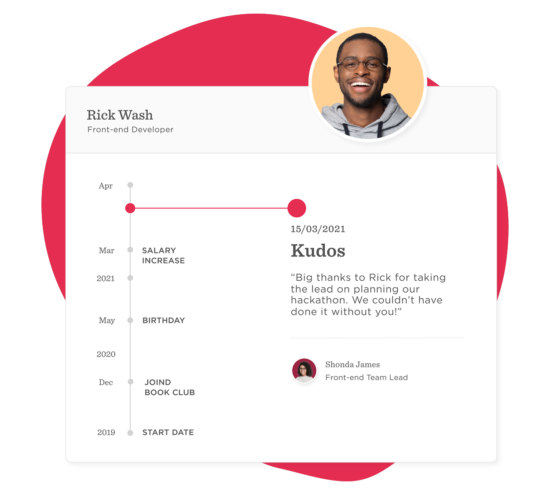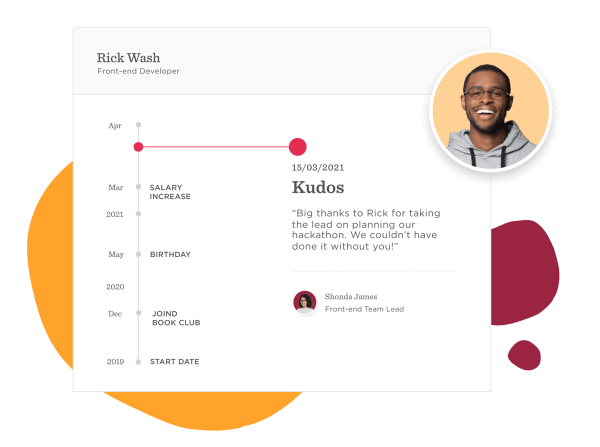Workplace practices and employee needs are evolving. HR professionals are taking the lead in building the new workplace. While remote work was rare in the 2010s, this is no longer the case. In 2018, the US Bureau of Labor Statistics published a report showing that 36 million Americans were already working from home at least occasionally, with 15% reporting that they had the option to do so.
This massive growth, however, has left the HR world scrambling to build new processes. For example, how can HR teams manage the highly personal performance review process when employees and managers don’t get together? How can dialogue-focused performance reviews thrive when employees and managers are separated by distance and even time zones?
Recommended Reading: Learn which HR KPIs are the most important

The problem: How do we conduct performance reviews with remote employees?
Performance reviews in their delivery and content aren’t static. They are intimately connected to the perceived value of labor and laborers, and they evolve as our work and our societies evolve.
In modern times and air-conditioned offices, we’ve moved to the flexible performance review. The two most common performance review models are:
- A competitive evaluation model with formal annual or semi-annual reviews in which employees are scored against each other, with the lowest-scoring employees dismissed (also known as pulling a “rank and yank”).
- A coaching and development model designed to help employees improve their skills, grow professionally and advance their careers.
The competitive evaluation model is firmly rooted in the industrial era and based on the Industrial Age-era belief that management creates value while employee labor is easily replaceable. This is in contrast to the reality of today’s world, in which each individual employee is recognized for their “soft skills,” creativity, or intellectual value to the organization.
Leading analyst and HR researcher Josh Bersin noted a radical shift away from industrial performance reviews. While ten years ago 75% of companies took the industrial approach, today the reverse is true. HR has evolved towards a review model that embraces growth and development.
“More than 85% of stock market capitalization is in intellectual property, brand, services, and software…so we need to invert the whole thing and understand that ‘managers serve the employees’ and not the other way around.”
Josh Bersin, HR thought leader
Performance management for remote employees
Over the last two decades, performance management, which emerged as a concept in the 1970s, has gained widespread traction in organizations. This change in performance management, however, has left many organizations struggling to redirect their culture, management style, and processes to meet the demands of a workforce that is now being transformed by Millenials.

The challenge: How to give frequent feedback when you don’t meet?
Personal growth is a huge priority for today’s employees. According to research conducted by The Robert Walters Group, a global recruitment agency active in 31 countries, 91% of millennials consider career development the number one priority in their jobs. The frequent, formal feedback that 60% of respondents said they wanted to receive on a monthly, bimonthly, or quarterly basis can help them continuously improve their skillset and performance.
In addition, a Gallup poll found that only 20% of employees say their performance is managed in a way that motivates them to do outstanding work, and only 14% feel that their performance reviews inspired them to improve.
These challenges, as well as current worries
for physical and financial health during the coronavirus pandemic, demand that
HR teams:
- Use the review process to encourage growth and inspire confidence and improvement.
- Help managers grow as coaches who can reassure employees about their well-being and develop their own people management skills
- Find new ways to track and report on HR-related data.
The solution: The new world of remote performance reviews
Today’s performance reviews should be as easy
to use as other remote work technologies and create an ecosystem of ongoing
feedback that happens through a continuous conversation between employees,
managers, colleagues, and customers.
Rather having a single annual meeting often taking place months after many of the events that are discussed during the review, performance review solutions should collect bite-sized performance data throughout the year based on regular check-ins, post-project debriefs, and end-of-quarter summaries.
The formal meetings should spend about 30% of the time focusing on past performance and 70% of the time on goal setting and discussing future projects. This model reinforces the manager as a mentor and enables employees to discuss their career development with managers and map out a path for growth, enabling both the manager and employee to accept responsibilities for setting and reaching goals.
Preparing for remote performance reviews
1. Identify the kind of data that needs to be collected. Data is still a key driver of performance management, even with a more modern style of performance review. Consider productivity, volunteerism for new tasks, readiness to help others, social engagement with peers, and other KPIs.
2. Test alternative tools for managing the performance review process. Use tools to assist in gathering and analyzing data in a way that streamlines the review process for employees, managers, and HR. Test tools to discover which one will best suit your organization.
3. Train managers in performance review and empathy. Train new managers and refresh the knowledge of veteran managers with new techniques to improve performance management and the use of empathy to increase team motivation and achievements.
4. Create a system that gives multi-directional feedback. Not only should feedback flow in all directions, from managers to employees, from employees to leadership, and between colleagues, but it also needs to include corrective feedback that is “sandwiched” between two layers of praise. This makes people more receptive to criticism and alleviates the discomfort of
5. Don’t let employees or managers opt-out. Create a culture where participating in an on-going performance review process is expected from everyone in the company. 100% participation will ensure the quality of data and create a sense of involvement in the future of the company.
Holding a successful remote performance review
1. Document performance throughout the year. Since remote communication is less dynamic and flexible than in-office coffee break chat, put communication, and ongoing performance reviews in writing. Look to HR management systems with informal chat or shoutout capabilities to recognize team members, keep them motivated throughout the year, and provide talking points for the formal review.
2. Come prepared with a deck or visual resource. Prepare a visual resource or slide deck for formal performance reviews, including some of your written communications and shoutouts. Sharing this document through video conferencing tools will let both managers and employees keep the conversation focused and ensure that you are both (literally) on the same page. In addition, a visual resource can help ensure that important events or achievements won’t be overlooked or forgotten, and provide a baseline for evaluating future performance.
3. Ask employees to evaluate their own performance. A self-assessment is arguably one of the most important parts of a productive review. It provides insight into how employees perceive their value to the company and how they want to develop. Self-assessments are also an opportunity for managers to learn how they can motivate and incentivize an employee. A self-assessment should include at least six or seven rating-scale questions, as well as three or four open-ended questions. When using HR software, built-in intelligence can analyze employee responses to assess flight risk and compare employee satisfaction among teams, across the company, or with industry baselines
4. Deliver praise and recognize high performance. Managers and employees often think that performance reviews are just for finding mistakes, and employees often underestimate their achievements. To be an example of empathetic leadership, take care to show that you understand their feelings, and repeat fragments of what they say to show that you’ve been listening. Be sure to call out specific achievements, temper self-criticism where warranted, and ask employees to share their own plans for growth in the next year or coming years.
5. Be empathetic and provide advice for improvement when delivering negative feedback. Remember that performance reviews can be stressful or even scary for employees—and even more so when done remotely. Delivering or receiving criticism isn’t easy, so take care to balance it with actionable advice for future improvement. Empathetic delivery will ensure that the performance review is an opportunity for growth that will keep employees motivated.
A pre-meeting checklist for managers and employees
- Send out a meeting invitation with an appropriate subject title
- Make sure that your computer equipment video camera and phone connection are working
- Prepare a quiet place for the meeting and arrange activities for children if needed
- Make sure you look presentable, awake and focused
- Re-read assessments or relevant materials to refresh your memory
- Make notes for any issues you want to raise in the meeting
Don’t eat during the meeting - Show empathy and recognize that this process also isn’t easy for the other person
- Remember to be present, focusing only on the meeting and your employee
Recommended For Further Reading
Meet Bob
We know how important it is to make holistic, data-driven decisions about your people, especially remote workers who may struggle to feel connected to your organization. That’s why we built Bob, an employee experience platform that helps HR leaders build a company culture that engages and retains employees and fosters comradery and commitment. The main tools that Bob uses to evaluate employee performance can be found in our advanced Surveys, Goal Setting, and Performance Management features.
Bob modernizes core HR functions
Surveys
Make data-driven decisions based on targeted questions.
- Enable anonymous feedback
- Measure culture
- Personalize surveys
Goal Setting
Help teammates stay aligned with personal, team, and company goals.
- Easy-to-track KPIs
- Identify top talents
- Assign objectives
Performance management
Define and optimize review cycles for understanding, transparency, and mutual trust.
- Customize questionnaires
- Build simplified dashboards
- Gain insights on performance
